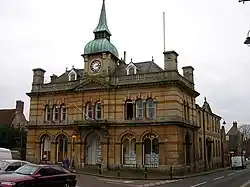Towcester Town Hall
Towcester Town Hall is a municipal building in Watling Street, Towcester, Northamptonshire, England. The town hall, which is the meeting place of Towcester Town Council, is a grade II listed building.[1]
| Towcester Town Hall | |
|---|---|
 Towcester Town Hall | |
| Location | Watling Street, Towcester |
| Coordinates | 52.1319°N 0.9882°W |
| Built | 1866 |
| Architect | Thomas Heygate Vernon |
| Architectural style(s) | Italianate style |
Listed Building – Grade II | |
| Official name | Town Hall |
| Designated | 19 August 1976 |
| Reference no. | 1371643 |
.svg.png.webp) Shown in Northamptonshire | |
History
After significant population growth during the early 19th century associated with the town's role as a coaching stop on Watling Street,[2] a turnpike road which had been paved by the engineer, Thomas Telford, local businessmen decided to form a company to develop a town hall and corn exchange: the site chosen was a prominent location in the market place which clearly defined its southern boundary.[3]
The foundation stone for the building was laid by the Earl of Pomfret, who lived at Easton Neston house, on 8 September 1865.[1] It was designed by Thomas Heygate Vernon in the Italianate style, built by John Wheeler with ashlar masonry and was completed in 1866.[4][5] It was constructed using Bath stone, with contrasting bands of Duston stone.[6] The design involved a symmetrical main frontage with three bays facing onto Chantry Lane; the central bay, which slightly projected forward, featured a round headed doorway flanked by pilasters and brackets supporting a stone parapet; there were two small rounded headed sash windows separated by a colonette and flanked by pilasters on the first floor and a carved pediment above.[1] The outer bays featured two large round headed sash windows separated by pilasters on the ground floor and three small rounded headed windows separated by colonettes on the first floor.[1] The design was modified at a late stage to include a clock tower at roof level with a zinc-clad belfry, (the addition of a clock having been made possible through subscription donations from 'the ladies of Towcester and the neighbourhood').[6] The clock was made by Moore & Sons of Clerkenwell,[7] but (as was not unusual at the time) appears to have been credited to a local clockmaker: Arthur Garrett of Towcester (whose name is visible just below the face of the clock). Internally, the principal room was the public hall;[1] there was also a working men's reading room, a working men's coffee room and several offices, as well as a shop and a private residence.[6]
On 29 March 1880 the clock tower and part of the surrounding roof were destroyed by a fire;[8] following rebuilding a new clock and bell were provided by Gillett, Bland & Co.[9]
After further growth and improved connections following the opening of Towcester railway station in April 1866,[10] the area was designated a rural district in 1894.[11] The building continued to serve as the headquarters of the local rural district council for much of the 20th century[12] and remained the local seat of government after the enlarged South Northamptonshire Council was formed in 1974.[13][14]
After South Northamptonshire Council decided to relocate to modern and more substantial promises nearby, the town hall became the responsibility of the parish council in 1983.[15] The parish council was superseded by Towcester Town Council which established offices in the town hall and subsequently used the building as its meeting place.[16] Although the committee room on the ground floor was leased out to estate agents, Bartram & Co. in January 2018,[17] the public hall has continued to be used for concerts and community events.[18]
References
- Historic England. "Town Hall (1371643)". National Heritage List for England. Retrieved 11 January 2021.
- Sunderland, John (1998). "The History of Towcester". Milton Keynes Heritage. Retrieved 11 January 2021.
- "Towcester: conservation area appraisal". South Northamptonshire Council. July 2012. p. 12. Retrieved 11 January 2021.
- Giggins, Brian (1 November 2019). "Towcester Guide". Towcester Town Council. p. 12. Retrieved 11 January 2021.
- The British Almanac. Knight & Co. 1867. p. 168.
- "Provincial News". The Builder. XXIV (1210): 273. 14 April 1866.
- Pickford, Chris, ed. (1995). Turret Clocks: Lists of Clocks from Makers' Catalogues and Publicity Materials (2nd ed.). Wadhurst, E. Sussex: Antiquarian Horological Society. p. 35.
- "Jottings". The British Architect and Northern Engineer. XIII: 166. 2 April 1880.
- Pickford, Chris, ed. (1995). Turret Clocks: Lists of Clocks from Makers' Catalogues and Publicity Materials (2nd ed.). Wadhurst, E. Sussex: Antiquarian Horological Society. p. 85.
- Jenkins, Stanley C. (1990). The Northampton & Banbury Junction Railway. Headington, Oxford: Oakwood Press. p. 18. ISBN 0-85361-390-7.
- "Towcester RD". Vision of Britain. Retrieved 11 January 2020.
- "No. 45242". The London Gazette. 3 December 1970. p. 13238.
- Local Government Act 1972. 1972 c.70. The Stationery Office Ltd. 1997. ISBN 0-10-547072-4.
- "No. 46391". The London Gazette. 1 November 1974. p. 10525.
- "Towcester Town in Drawings". Towcester and District Local History Society. Retrieved 11 January 2020.
- "Council Meeting Agenda" (PDF). Towcester Town Council. 13 January 2020. Retrieved 11 January 2020.
- "Premises Committee Meeting Agenda" (PDF). Towcester Town Council. 15 January 2018. Retrieved 11 January 2020.
- "Towcester Town Hall, with Towcester Choral Society and guests". Oxford Welsh Male Voice Choir. 7 July 2017. Retrieved 11 January 2020.